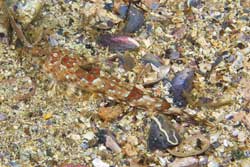New species of fish in Sweden

A reticulated dragonet, a new species in Sweden, well camouflaged against the seabed in the Väderöarna. Photo: Lars-Ove Loo<br>
Lars-Ove Loo is the underwater photographer who has captured the fish on film. He saw it while making an inventory ahead of the creation of a new nature reserve in the islands. This was in August 2010, 19 meters below the surface of the sea south of Lyngö in the southern Väderöarna (58° 32.554’ N, 11° 05.373’ E).
Reticulated dragonet (Callionymus reticulatus) is similar to its more common Swedish relatives the common dragonet and spotted dragonet. The male reticulated dragonet is just 11 cm long and the female 6.5 cm long. It has three spines on its gill cover, whereas the other two species have four. Its snout – the distance from mouth to eye – is somewhat longer than its eye is wide.
Reticulated dragonet is found from the Weather Islands in the north down the coasts of the southern North Sea, in the Irish Sea, from southwestern Ireland down to Portugal, and in the western Mediterranean. It has been found both in shallow waters and at depths of up to 110 metres.
It is unusual for a new species of fish to be discovered in Sweden. There are now an estimated 265 species of fish in the country, of which just over 200 dwell in the sea.
For more information, please contact: Martin Larsvik
Telephone: +46 (0)31-786 96 21
E-mail: martin.larsvik@loven.gu.se
Media Contact
More Information:
http://www.gu.seAll latest news from the category: Life Sciences and Chemistry
Articles and reports from the Life Sciences and chemistry area deal with applied and basic research into modern biology, chemistry and human medicine.
Valuable information can be found on a range of life sciences fields including bacteriology, biochemistry, bionics, bioinformatics, biophysics, biotechnology, genetics, geobotany, human biology, marine biology, microbiology, molecular biology, cellular biology, zoology, bioinorganic chemistry, microchemistry and environmental chemistry.
Newest articles

Properties of new materials for microchips
… can now be measured well. Reseachers of Delft University of Technology demonstrated measuring performance properties of ultrathin silicon membranes. Making ever smaller and more powerful chips requires new ultrathin…

Floating solar’s potential
… to support sustainable development by addressing climate, water, and energy goals holistically. A new study published this week in Nature Energy raises the potential for floating solar photovoltaics (FPV)…

Skyrmions move at record speeds
… a step towards the computing of the future. An international research team led by scientists from the CNRS1 has discovered that the magnetic nanobubbles2 known as skyrmions can be…





















